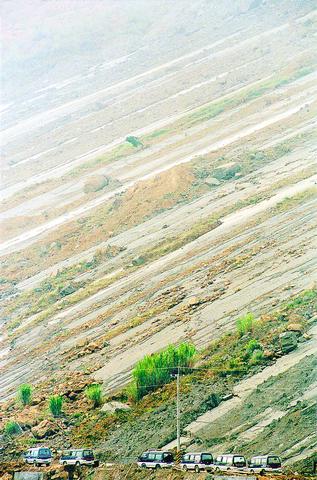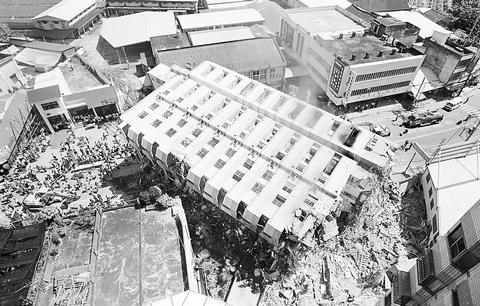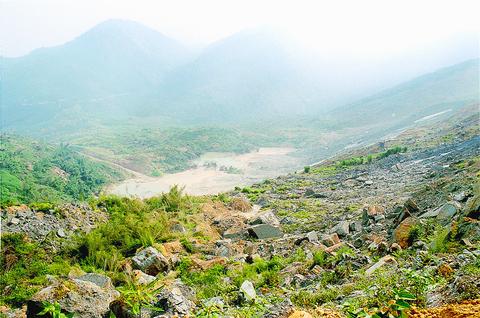Taiwan's massive 921 earthquake that killed 2291 people created a huge fault displacement, tearing the ground apart for 100 continuous kilometers primarily through urban and suburban areas. The Chelungpu (車籠埔) fault scarp is a scar that will never go away.
Just after 1:47am, the time of the initial earthquake, You shu-fong (
One year later, in Fengyuan (豐原), only 7km from Taichung, I walked along Highway 3. Through the barren swath of dusty vacant lots where homes and buildings once stood, I was confronted with the harsh reality of how many lives had been destroyed by the earthquake. Experts now know more about how deaths and injuries could have been prevented. But serious questions remain as to whether the responsible parties in Taiwan have learned from this tragedy.

PHOTO: CHEN CHENG-CHANG, TAIPEI TIMES
At the nearby Tachia river (
At National Taiwan University, Dr Chen Yue-gau (
The reason Taiwan exists at all is because of what geologists call decollement or "the snowplow theory." As the Philippine sea plate collides with the Eurasian continental plate, it acts as a snowplow. Sediments that had been lying on the bottom of the sea are "squeezed up into mountains and pushed westward. The thrust faults are penetrating right into the surface one by one westward," said Chen. The Chelungpu fault runs counter to this argument because it is east of the trend.

PHOTO:SUNG CHIH-HSIUNG, TAIPEI TIMES
Lack of funds
But usually science can only achieve results as good as the funding behind it, and, as Chen said, government funds were tight because of an attitude of indifference. "Before the earthquake the majority of people didn't have any idea about earthquake disasters," Chen said, who adds that it was way back in 1935 when the last devastating quake hit Taiwan. "People have almost forgotten about these kinds of things. The natural habit in Taiwan is that earthquakes are not very important because the reoccurrence interval is too long -- tens, hundreds or thousands of years.
"There was not enough financial support. We didn't have modern facilities or equipment to monitor crust deformation or for taking high-precision GPS measurements. We just spent our time on field work," Chen said.

PHOTO: CHEN CHENG-CHANG
However, since the 921 earthquake, Chen feels attitudes have been changing, and earthquake research is receiving more equipment, funds and manpower. "It is a little bit late, but still not too late if we can prepare for another one. Now we can tell our government where the most dangerous place will be, and what the probability of an earthquake is," he said.
But although the earthquake was unexpected, many engineers think there should not have been so many building collapses leading to loss of life.
Loh Chin-hsiung (
Chen Hsue-bin (
Although nothing could be done about the 10 percent of total deaths in buildings directly on the fault which were immediately wrenched in half, most deaths were related to poorly built structures which collapsed in other areas. "Two-thirds of the people died in poorly built buildings," Chen said. "We should have at least avoided these casualties."
Bad policies
But Chen thinks these people died "because of bad policies."
"Ninety-nine percent of present building jobs are run by architects. There are no engineers involved," said Chen who explained that current laws do not ensure that people will follow building codes and are not strict enough to require engineers experienced in earthquake or structural engineering to be part of any building project. In spite of the earthquake, the laws remain almost unchanged to this day
Dr Shannon Lee (
"Seismic engineering," Chen added, "involves lots of detail and special design, called ductile design. Most architects don't understand ductile design, but they think they can do it. They don't think it's that important."
Engineers think the facts speak for themselves. "None of the collapsed buildings where people died were over 16 stories because these buildings must be designed by structural engineers, and they need to be double-checked," Chen said. There are over 200 of these tall buildings in the earthquake disaster area, primarily in Taichung. However, "the 12-story high-rise buildings just completely collapsed. Even in the strongest earthquake there shouldn't be a total collapse," Chen said. He explained that buildings 12-stories and less do not need inspections or a structural engineer, only a civil engineer. "At most, five percent of civil engineers in Taiwan have training in structural engineering," Chen said.
"For buildings five stories or below an architect can do the structural design," said Chen. "A building is still a building. Any kind of building needs to be designed right -- it doesn't matter how high or low," he said.
"Our building policy is really copied from Japan," Lee said. He explained that in Japan architects also have control and authority over the construction process but there are comparatively fewer poorly designed buildings. "In Japan, structural engineering training is included in the architecture department," Lee said, explaining that in Japan architects are more qualified than in Taiwan. However, he said, "the architects in both the US and Taiwan are always proud of not being engineers. They are artists."
In the US, architects do not usually have as much control over projects, and the process of ensuring quality is different. "Professional liability is different," Chen said.
"Many things in the Taiwan system are copied partially from Japan, partially from the US. But put together it's not right. They choose what they want and if there's some other part they don't want they just delete it, and that's not right," Chen said.
Unlike Turkey's August 1999 earthquake leading to outright devastation due to faulty construction by corrupt contractors, Chen thinks Taiwan's system "has nothing to do with corruption. It's just bad policy."
Lee's opinion is similar. "In Taiwan, maybe only about five percent of people intentionally make bad buildings," he said.
In Taiwan, "three lawsuits resulted in sending three or four people to prison. This included architects and engineers. Sixty architects have been sued. Most of the cases have not yet been settled," Chen said.
If anything has changed for the better it is that the larger construction companies are now paying more attention to the law. "The government is checking now. The construction companies are aware and are acting more responsibly. They're scared," Chen said, "But this is not true for architects because the buildings are still not designed by qualified people."
Better protection
The government has made changes in the past year which it says will better protect people from dangerous buildings.
"Originally," Loh said, whose center is key in advising the government, "we had four zones in our seismic design code ... but now it has become two zones," he said, referring to the fact that areas of Taiwan have been categorized into two zones requiring stricter building codes. Besides re-zoning, Loh said modifying the building codes is the second major part of the government's initiative.
But how can the government make sure the contractors and builders follow the building codes?
"I think that belongs to education," Loh said. "In our center we have a program to educate the general public to let them know what kind of structural system or construction is a good one."
Chen disagrees. "What he says is completely wrong. Ordinary people don't have that kind of knowledge and they don't need to have that kind of knowledge -- because this is a real specialty. Loh says that because he's a government speaker. I argue with him all the time."
"[The new building codes and zoning laws] gave people the wrong impression -- that we need a stricter code, but it's not true," Chen said.
Both Chen and Lee emphatically believe that the only way to improve building quality is to require people qualified in structural engineering to design structures and to have experts double-check the structural quality.
"We are pushing for tougher legislation," said Chen. "If you design a building that collapses and kills people and if an investigation finds you are responsible -- you will get life in prison. But the architects have their friends in the Legislative Yuan -- they are trying to stop the legislation," he said.
"Architects," Lee said, "make up [a large portion] of the Construction and Planning Administration and they keep up pressure so that architects keep the jobs.
"In this country, architects have a lot of political power," Chen said. "Most of the building officials in the local governments are architects," he said.
"Change," Chen emphasized, "must come from educating people about the problem. It must be handled through everybody's effort."
Gregory Michaels was a planetary geologist at NASAs Jet Propulsion Laboratory from 1990 to 1993, a NASA research assistant from 1993 to 1998 and a geophysicist in Azerbaijan from 1998 to 1999.

The CIA has a message for Chinese government officials worried about their place in Chinese President Xi Jinping’s (習近平) government: Come work with us. The agency released two Mandarin-language videos on social media on Thursday inviting disgruntled officials to contact the CIA. The recruitment videos posted on YouTube and X racked up more than 5 million views combined in their first day. The outreach comes as CIA Director John Ratcliffe has vowed to boost the agency’s use of intelligence from human sources and its focus on China, which has recently targeted US officials with its own espionage operations. The videos are “aimed at

STEADFAST FRIEND: The bills encourage increased Taiwan-US engagement and address China’s distortion of UN Resolution 2758 to isolate Taiwan internationally The Presidential Office yesterday thanked the US House of Representatives for unanimously passing two Taiwan-related bills highlighting its solid support for Taiwan’s democracy and global participation, and for deepening bilateral relations. One of the bills, the Taiwan Assurance Implementation Act, requires the US Department of State to periodically review its guidelines for engagement with Taiwan, and report to the US Congress on the guidelines and plans to lift self-imposed limitations on US-Taiwan engagement. The other bill is the Taiwan International Solidarity Act, which clarifies that UN Resolution 2758 does not address the issue of the representation of Taiwan or its people in

US Indo-Pacific Commander Admiral Samuel Paparo on Friday expressed concern over the rate at which China is diversifying its military exercises, the Financial Times (FT) reported on Saturday. “The rates of change on the depth and breadth of their exercises is the one non-linear effect that I’ve seen in the last year that wakes me up at night or keeps me up at night,” Paparo was quoted by FT as saying while attending the annual Sedona Forum at the McCain Institute in Arizona. Paparo also expressed concern over the speed with which China was expanding its military. While the US

SHIFT: Taiwan’s better-than-expected first-quarter GDP and signs of weakness in the US have driven global capital back to emerging markets, the central bank head said The central bank yesterday blamed market speculation for the steep rise in the local currency, and urged exporters and financial institutions to stay calm and stop panic sell-offs to avoid hurting their own profitability. The nation’s top monetary policymaker said that it would step in, if necessary, to maintain order and stability in the foreign exchange market. The remarks came as the NT dollar yesterday closed up NT$0.919 to NT$30.145 against the US dollar in Taipei trading, after rising as high as NT$29.59 in intraday trading. The local currency has surged 5.85 percent against the greenback over the past two sessions, central